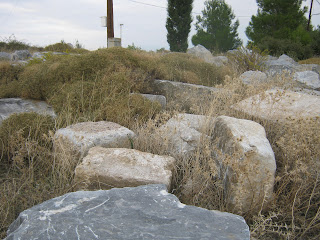Οχι Day! and my birthday!
We began the holiday at Meteora where Cathy gave her report on the monasteries that were built up on the rocks. We checked out St. Stephen's monastery and then came back over to the Great Meteoron monastery.
The rocks where the monasteries were built are amazing. The monks of the past used net lifts to get people up to the building. These days there are cable cars and extensive staircases.
We also found some treasures within the monasteries. In the Great Meteoron, there were several museum rooms. One, which didn't allow pictures, had all manner of manuscripts including a 1502 copy of Lucian! Another featured the history of the Greek military with mannequins dressed in military dress from several different time periods. The best, however, was the painting featuring Homer, Socrates, Plutarch and others as prophets of God. Even better was the placard showing how the great Greek writers of the past had predicted the coming of Christ (even though they didn't).
Our next stop was at a small museum in Karditsa where Allie gave her report on the cult statue of Apollo from the temple of Apollo in Metropolis. The museum doesn't allow photography inside, so I took a picture of the statue on one of the banners outside the museum.
After the museum, we went to the site of the temple where Allie continued her report. Sadly, no one asked any Superman related questions (we were at Metropolis . . . get it?).
The Greek man working at the guard house of the site was so excited to see us. He showed a few of us pictures of the dig when the statue of Apollo was found. He also gave us some tree leaves that after being rubbed together a bit smell strongly of citrus.
Not far from the temple site, we stopped at a tholos tomb.
Next we had a look inside an old church building at a cemetery which had a Trajanic mile marker built into one of its columns.
Outside the cemetery, we looked out on the plain where the battle of Pharsalus (48 BCE) occurred.
Not a bad way to spend the first day of my thirties.


















































